Nomination Forms Toolkit – England
This toolkit will help you fill out your nomination forms for English Local Council Elections. This is the legal paperwork you must complete in order to stand in elections as a Liberal Democrat candidate on the ballot paper.
You can download your full pack of English nomination papers from the Electoral Commission website. Even if you council produces its own nomination papers you can still use the Electoral Commission ones.
The Local Election 2025 deadline for SUBMITTING your nomination forms is 4pm on Wednesday 2 April. You can download a full timetable for local elections in England here.
Remember if you are sorting the local nomination paperwork for Combined Authority Mayoral elections these have different nomination papers. You can download the forms here for Mayoral elections.
It is vital that you submit early. The deadline is final and there is no appeal. Make sure your forms are in and accepted several days before the deadline. If something goes wrong you need to leave yourself time to correct any mistakes.
You should check your eligibility to stand in the forthcoming election. There are a number of criteria that make you eligible to stand, and a number of criteria that can also disqualify you from standing. You can check your eligibility with the Electoral Commission’s Guidance for Candidate’s and Agents here.
Arrange a date to go into the Elections Office at your Local Council a few days in advance of the deadline for submitting your nomination forms – and let them check that all your forms are correctly filled in. This is known as the informal check and allows you to ensure the forms are correct before formally submitting them.
This toolkit will take you through each form you need to fill in as follows. You should complete your forms in BLACK INK and make efforts to make your writing as legible as possible.
1a: Nomination Paper
1b: Home Address Form
1c: Candidate’s Consent to Nomination
2: Certificate of Authorisation
3: Request for Party Emblem
4: Notification of Election Agent
1a: Nomination Paper
The first section of your Nomination paper is where you fill in details about your ward, council and polling day date.
First of all write your division/ward name in the first box box at the top of the page. Then write the name of your Council in the second box right below. Finally write the Polling Day date in the third box right below that.
The second part of the Nomination Paper is where you fill out your personal details as a candidate. You must fill out your full surname and forenames as they appear on the electoral register. You may use a title; for example, if your actual name is Joseph Smith but your hereditary title is Joseph Avon, you can use the name Joseph Avon as your full name.
You are able to give a commonly used name – for instance, a candidate named Robert may reasonably appear on the ballot as Bob. The returning officer has the right to disallow any name which is deemed to be offensive or they feel is aiming to deceive the electorate. Similarly, a person known by a surname other than their legal surname (for instance, their surname before marriage which they keep professionally) may also ask for this commonly used surname to appear on the ballot. However, you can use a name that is already part of your full name, so if you are Catherine Helena Yates but everyone calls you Helena Yates, you cannot use Helena as your ‘know as’ name. It is a good idea to check with the elections team before submitting your paperwork as to what they will accept.
Remember to also indicate your preferred honorific (Mr/Mrs/Ms etc) in the box provided.
The ‘Description’ box in this section is also where you give the party name. This must match the party name you give on your Certificate of Authorisation form. The party name is Liberal Democrats, and this is the recommended term. Alternatively, you can use one of the registered descriptions (you cannot vary these in any way):
- Liberal Democrat
- Liberal Democrats – For a fair deal
- Liberal Democrat Focus Team
- Focus Team
More details can be found here.
The third section of the Nomination paper is where the ‘Subscribers’ in your ward / division sign your papers in order to nominate you to stand.
Remember that local government elections in England only require 2 signatures from subscribers in your ward now.
The subscribers who nominate you must:
- Be registered voters in the ward/division in which you are standing.
- Be 18 years of age or over on polling day. Therefore they can be 17 at the present moment but must have their 18th birthday before polling day.
- Give their name exactly as it appears on the electoral register. For instance is on the election register as Richard William Smith – but is commonly known as ‘William’ – they must still complete their forms as Richard William Smith.
- Only nominate the same number of candidates as there are vacancies (so if the ward has one councillor up for election, they can only nominate one candidate but if it is a three member ward and all are up for election, they can nominate 3 candidates). If they sign too many papers, only those submitted first will be accepted.
You must fill out the Electoral Roll number for each subscriber. This consists of the two letter Polling District Code followed by their unique elector number as it appears on the electoral register. An easy way to search whether a voter is registered in your ward/division, and to verify their electoral roll number, is to look them up on Connect. Alternatively you can find these details on a hard copy of the electoral register for your ward that you can find in your Council’s Elections Office. You can check the election numbers with the election office before submitting.
An example of a completed 1a: Nomination Paper for the 2023 Local Elections (requiring just 2 nominations) is below.
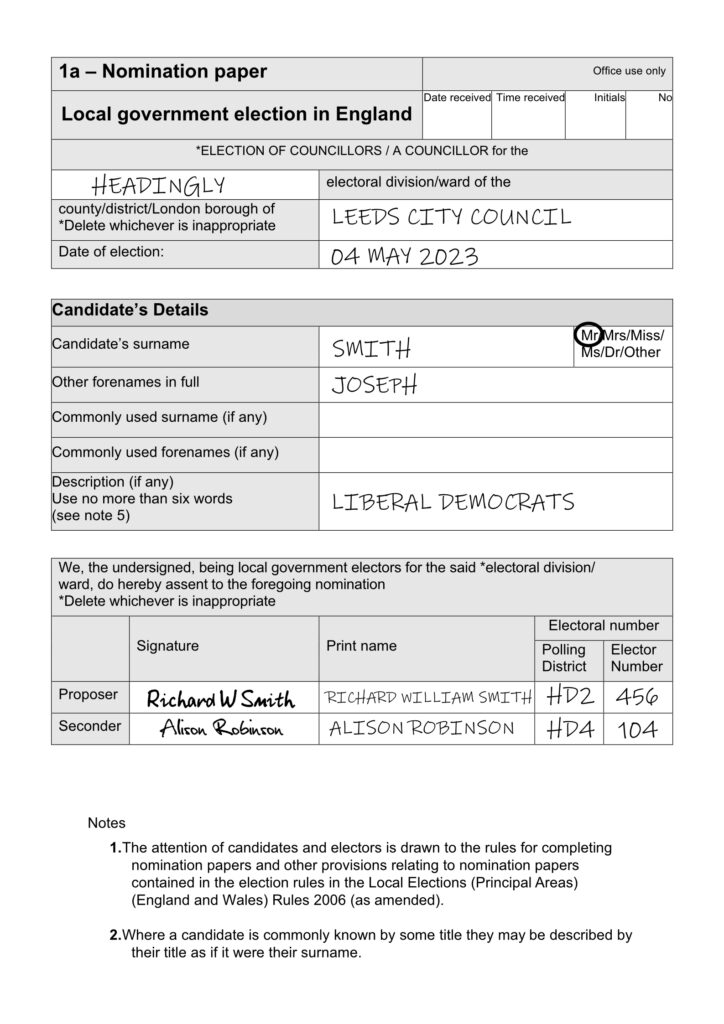
1b: Home Address Form
The Home Address Form is where you provide evidence of your eligibility to stand – either by demonstrating that you live within the Council area in which you are standing or by demonstrating that you work / own property / exist on the electoral register in that Council area.
You must fill out your home address as part of this form.
It is possible for your home address to be withheld from the public and not be displayed on ballot papers. You can choose to withhold it on the second part of this form.
The first section of this form is identical to the first section of the Nomination Paper form above.
Enter the name of the ward/division in which you are standing in the first box, the council name in the second box and then enter the date of polling day in the third box.
The next section of this form is where you enter your full name and home address. Your full name must be your registered name as it appears on the electoral register (rather than your commonly used name) and your home address must be given in full.
In the next section you must give your ‘Qualifying Addresses’ which are the relevant addresses against each of the criteria you meet to stand as a candidate. You should fill out each criterial that you meet by filling out the full relevant address. You must strike through any qualification you do not have as shown on the example form below.
Finally on this page you must get a witness to write their full name and home address in the relevant boxes. This must be the same witness who signs the other necessary forms you need to submit.
An example completed 1b: Home Address Form is below:
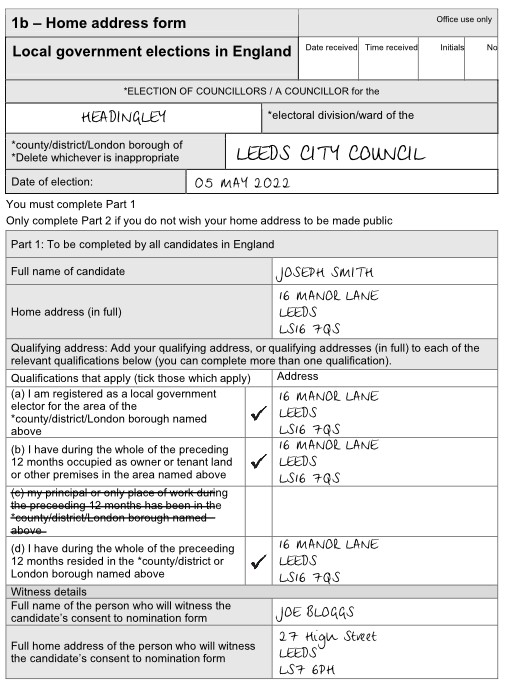
If you wish for your home address to be withheld from the public – so that it will not appear on the ballot papers, notice of poll or statement of persons nominated – you must complete Part 2 of the Home Address form in your nomination pack and physically submit it with your other nomination paperwork.
If you are happy with your home address being published on ballot papers you don’t need to complete or submit this form.
1c: Candidate’s Consent to Nomination
Please note that you may not sign this part of the nomination forms more than one month before the deadline for the submission of nomination papers.
On this page, enter the name of the division / ward you are standing in and the date of Polling Day.
Fill in your date of birth in the box provided and sign and date. This must be done in the presence of the same witness who signed the 1b: Home Address Form and on this form they must give their full name and signature.
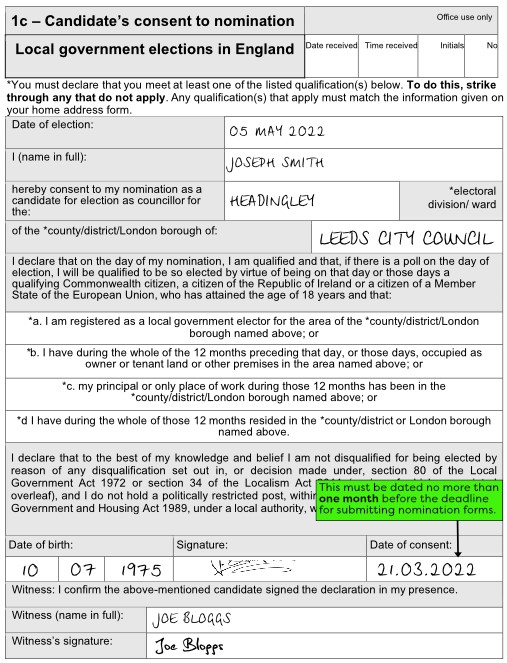
2: Certificate of Authorisation
This is the form that confirms you have permission to stand for the Liberal Democrats. As you are standing on behalf of the Liberal Democrats you must complete this form.
First of all enter the name of the ward/division you are standing in and the date of the election.
To confirm your permission to stand for the Liberal Democrats this form needs to be signed by the party’s designated nominating officer for your area. You may already know who the Delegated Nominating Officer (DNO) to sign this in your area is – but if you do not you should contact your regional party or Sarah Morris on sarah.morris@libdems.org.uk.
You should then put ‘Liberal Democrats’ in the box for the registered political party.
If you used a different party description on your 1a: Nomination Paper form – for instance ‘Liberal Democrat Focus Team’ or ‘Liberal Democrat’ you must add the exact same description in the next box for party description. If you have just used the ‘Liberal Democrats’ party name as the party description on your 1a: Nomination Paper just write Liberal Democrats again in the party description box.
If the party description on the Nomination Paper and Certificate of Authorisation do not match your paperwork will be invalid. Even the difference between Liberal Democrat and Liberal Democrats is enough to get your nomination papers rejected.
The Delegated Nominating Officer needs to fill in the rest of this sheet.
An example Certificate of Authorisation form in below:
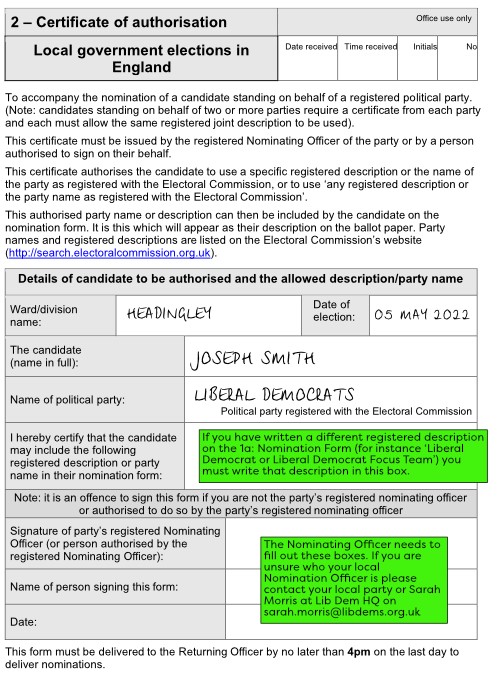
3: Request for Party Emblem
This form allows the party’s ‘liberty bird’ emblem to appear alongside your name on the ballot paper.
Again, you should fill in the ward/division name and the date of polling day. You should then give your full name.
When giving the emblem description, use the exact Description. For England this is:
- ‘A bird in flight above the words Liberal Democrats’ [Emblem ID 106]
An example for the English party logo is below:
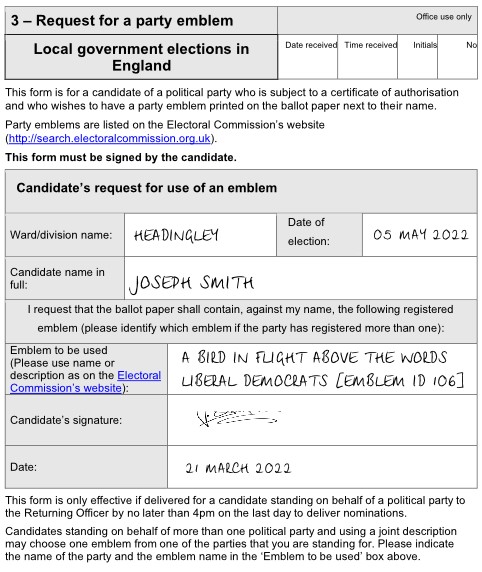
4: Notification of Election Agent
On this page, you can nominate your agent – the person legally responsible for your campaign and the return of your expenses forms after polling day.
You will see that you have to provide both your details and those of your agent. Ideally, your agent should have undertaken Election Agent training with the party or ALDC. You should always check with your intended agent before completing any part of this form.
The requirements to be an agent are less onerous than to be a candidate but you must also register the agent’s office address. This could be a home address or a party office address. It cannot be a PO Box or similar. The address, for English local elections, must be:
- within the same local government area where the election is being held,
- or within the UK Parliamentary constituency included in the local government area,
- or within one of the constituencies or adjoining constituencies either partially or wholly included in the local government area,
- or within a Welsh county borough which adjoins the local government area,
- or within a borough or district in London which adjoins the local government area
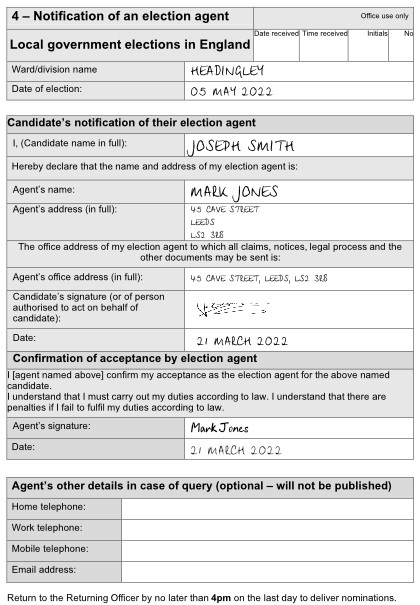
If you need any advice when completing your nominations paperwork you can call our ALDC helpline on 0161 302 7532 – which is open Monday to Friday from 9.30am to 4.30pm.